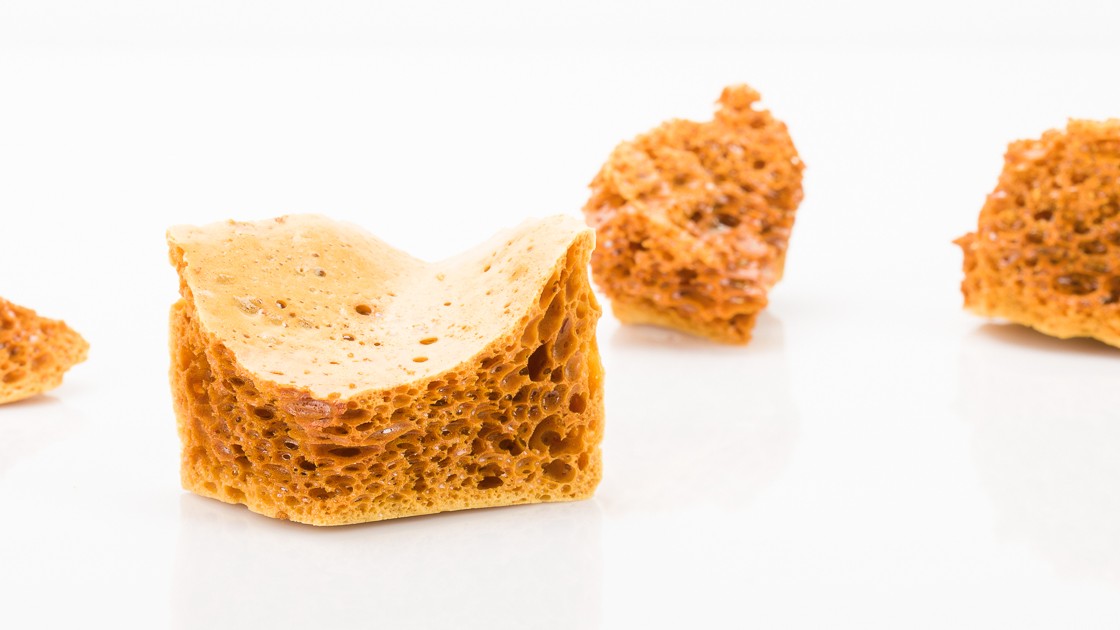This easy make it yourself honeycomb is the tasty foodie version of the volcano experiment from middle school science class. Use the sticky sweet honeycomb to garnish your favorite desserts.
Ingredients
- 200g (¾ C + 2 Tbsp) Granulated Sugar
- 35g (2 Tbsp + 1 Tsp) Honey
- 50g (5 Tbsp + 1 Tsp) Glucose Powder
- 60g (¼ Cup) Water
- 13.5g ( 1 Tbsp + 1 Tsp) Baking Soda

Equipment
- Large Heavy Bottom Pan
- Whisk
- Baking Tray
- Non Stick Baking Mat or Parchment Paper
Timing
Active Time: 15 Minutes
Total Time: 15 Minutes
Yield
15 to 20 Portions
-
Mix and Heat
Combine the sugar, honey, glucose powder and water in a large heavy bottom pan (a large pan is important for safety, once the baking soda is added, the mix expands a lot)
Blend together and on a medium high flame, cook until a light amber caramel ( 320-335°F)
-
Add Baking Soda
Once the caramel is reached, remove from heat and add all the baking soda and whisk for 1 minute.
-
Cool and Serve
Pour onto a baking tray and let cool.
Once cool, break apart into desired pieces and serve.
Summary

Recipe Name
Author Name 



 Based on 8 Review(s)
Based on 8 Review(s)
One Minute DIY Honeycomb
Modernist Pantry
Published On
Preparation Time
Total Time
Average Rating




 Based on 8 Review(s)
Based on 8 Review(s)

15 Comments.
Gin is included in the ingredient list but not referred to again in the recipe. When/how is it incorporated?
Just a typo, fixing it now!
What is the gin in the recipe for?
Just a typo, fixing it now!
How do you serve this? Does it really look and taste like honeycomb?
It’s not meant to replicate a honeycomb, the honeycomb is referring to the airy pockets. Typically it’s broken up and used as a garnish on various desserts.
Regarding Nancy’s question about how to serve honeycomb, speaking as a hobbyist chocolatier, it’s a popular item to dip in tempered chocolate. Also, one of my favorite truffles uses a white chocolate ganache with malt syrup added, which gets rolled in honeycomb (broken into small bits) and then dipped into tempered chocolate (the recipe is in the book, *Chocolate Obsession*).
Note that honeycomb is very hydrophilic (it absorbs moisture easily). If left exposed, it goes bad quite quickly, even in relatively dry weather. So if you aren’t eating it right away, wrap it tightly and store it in an airtight container. Or dip it in tempered chocolate—it seals out the moisture!
Hello chef,
I just wondering with your modernist pantry ingredients and testing kitchen if you ever come across of make soufflé with some kind of stabilizers that it would not fall or last a little longer without collapsing? Also I try to understand how does all proffessional restaurant/ kitchen could able to cook the soufflé during service where many people ordered in different timing. Their oven door is constantly open and close to put the new one in while the old one is still cooking and rising. How does it’s doesn’t fall or collapse on them? Is not like they have 10-20 ovens for each soufflé. Could you please give me a hint how does al the chefs manage to bake them perfectly?
Yes, you can stabilize a souffle by adding versawhip . We do have a recipe that we created for Pastry Arts magazine that used versawhip to create a free standing souffle. Will probably cover it in a WTF episode some time.
Hi!
Can I use fructose instead of glucose powder?
Not sure if this will work. We have not tried it.
Is it ok to use glucose in his syrupy form instead of powder ?
Yes, but it will be different ratios and not a straight 1:1 substitution for the glucose powder + water.
can you substitute liquid glucose for the powder and water? if so how much
You can substitute liquid glucose for powder and water, but since we have not tested it we don’t know the exact difference. It is not a 1:1 substitution.